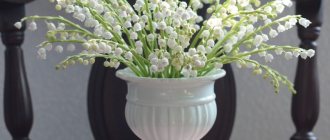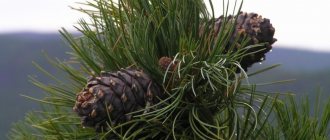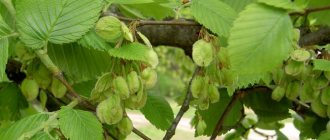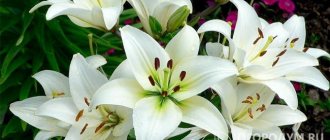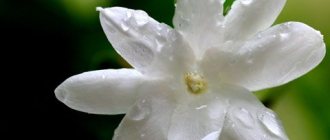Among the ground cover plants there are many beautifully flowering and lacy-leaved stars flaunting their unusual metallic effects. But if other inhabitants of alpine hills can boast, first of all, of their external effectiveness, then Antennaria captivates with something completely different - with its endurance and undemandingness. Known as cat's paw, this very easy-to-grow ground cover is not the most showy plant, but it is unusual and attractive throughout the year. And one of the most reliable.
Cat's foot or Antennaria dioica. © rocayflor
What does antennaria look like?
Antennaria is a graceful stem about 30 centimeters high with soft, straight, light green leaves covered with fine silver down.
The flower itself consists of several inflorescences about 5 millimeters in size, collected together. They look tender and fluffy, for which they received a separate popular name “cat's paws”.
Antennaria may look different in the photo. The main difference is the color, it can be in different shades from snowy white to hot pink.
Most Antennaria species bloom between May and July or June and August. The flowering period usually lasts one and a half months.
general description
A numerous genus, native to the Arctic and high mountain regions of North America, Europe and Asia. As an ornamental plant, Antennaria has become widespread throughout the world. The culture has a second interesting name, common among the people - cat's paw, since at the end of flowering the baskets resemble the pads of cats' paws.
It is a low perennial up to 30 cm in height, quickly growing on the sides thanks to creeping shoots that quickly take root. The grassy carpet spreads 50 cm in diameter, so some time after planting the soil is densely covered with greenery. The root is thin, located under the surface of the earth. The leaf blades are densely covered with whitish fibers, giving the leaves a silvery tint. The function of these villi is to retain and preserve moisture.
Flowering begins in May and continues until June-July. The buds are collected several times in baskets. The flowers are morphologically different: there are male and female. Men's are most often white, while women's are often painted in other colors. By the end of summer, small seeds ripen and can successfully spread by self-sowing.
Popular types of Antennaria
Most often in the garden you can find several common types of antennaria:
Dioecious
It differs in that it is larger than other types of antennaria. It begins to bloom earlier and its flowering period lasts longer than usual - about two months. Another important difference is its frost resistance and the fact that the flower does not change its color even under snow. The dioecious antennaria has many unusual decorative forms, which are also popular:
- Rubra - large red flower
- Rosea is a deep fuchsia flower.
- Aprica - has a soft white color
- Tomentosa - distinguished by beautiful silver leaves
- Roy Davidson - has purple flowers and rich green leaves
- Minima is famous for its small size - just 5 centimeters in height and covered in tiny pink flowers.
Carpathian
It differs in that the narrow leaves have a gray tint, the peduncles are not covered with down, and the flowers have a delicate pink tint. Most often distributed in mountainous areas.
plantain leaf
A rare variety of Antennaria, the leaves of which are very similar in appearance to plantain leaves. Of all the species, this one has the largest inflorescences, which are most often white.
The name characterizes not only the appearance of this variety, but also its similarity with another main quality of plantain - the ability to survive in any conditions and on any soil.
Alpine
The leaves of this Antennaria wine are bluish in color, they grow thickly at the base and cover the ground with a beautiful silver carpet. The inflorescences of this variety are always white and have a soft cotton texture.
Words and expressions that are close in meaning
| Word | Synonyms |
| dammara agathis, dammar, fish, resin | |
| acne acne, tubercle, fish, eel | |
| elasmobranch shark,… | |
| angelfish shark, fish | |
| constellation altar, andromeda, argo,… | |
| albacore tuna, fish, mackerel | |
| cupid cupid, asteroid, god,... | |
| climbing frame, crosshead,... | |
| anchovy anchovy, anchovy, fish,… | |
| astrologer, astronomer, sorcerer,... | |
| sailboat butterfly, brig, brigantine,… | |
| red mullet, bird, fish | |
| whitefish, ludoga, muksun,… | |
| nelma whitefish, fish | |
| pike perch bersh, city, perciformes,… | |
| Bremsberg ramp, hip,… | |
| cod loaf, fish, bread | |
| goby, bull, butt, sculpin,... | |
| sculpin goby, fish | |
| vampire mouse, nocturnal mouse, harpy,... | |
| navaga vakhnya, fish, cod | |
| argus giant, bird, fish, guardian,... | |
| tench rope, cage, line,... | |
| top char, fish | |
| roach roach, carp, roach,… | |
| swordtail warrior, fish, servant | |
| surgeon, cardiac surgeon,... | |
| spike, protrusion, sound, needle,... | |
| neon gas, fish, element | |
| herring galdya, zalom, ivasi, fish,… | |
| gamma-ray telescope,… | |
| bester hybrid, fish | |
| flounder glossa, kalkan, fish | |
| rotan firebrand, fish | |
| firebrand smut, log, rotan, fish | |
| sajda city, lur, port, fish,… | |
| dace city, fish | |
| kaluga city, fish | |
| greenfinch mushroom, bird, fish | |
| killer whale dolphin, mammal,… | |
| madder tree, speck, speck,… | |
| slab board, material,… | |
| sprat shot, fish | |
| barbel lumberjack, beetle, fish, man | |
| limanda ruff, fish | |
| pipe cleaner, tool, fish,... | |
| sheresper asp, fish | |
| live bait fish, whitebait, little fish,… | |
| lamprey animal, fish | |
| congestion, traffic jam, fish, herring | |
| sardine iwasi, fish, sardine | |
| hedgehog-fish pufferfish, fish | |
| pufferfish body, fish | |
| moonfish pufferfish, fish | |
| triggerfish pufferfish, fish | |
| Myron name, fish | |
| carp name, fish, carp | |
| cockerel iris, rooster, plant, fish,… | |
| Ishkhan trout, brown trout, salmon, fish | |
| glossa flounder, comment,… | |
| kalkan flounder, fish | |
| crucian carp, crucian carp,... | |
| carp carp, fish | |
| Katran shark, elasmobranch,… | |
| sprat sprat, fish, sprat | |
| sprat sprat, fish | |
| bighead whale, fish | |
| Chukuchan skate, fish | |
| pegasus horse, horse, fish,... | |
| pink salmon, fish | |
| umber paint, pigment, fish | |
| red sockeye salmon, fish | |
| salmon trout, sucker, fish, trout | |
| speckled trout, fish | |
| taimen trout, fish | |
| cheese food, peled, fish, cheese | |
| bream bream, fish | |
| Limanda ruffed fish, fish | |
| Velcro stuck, annoying... | |
| dodgy loach, sneaker, fish | |
| trout salmon, parsley, fish,… | |
| mackerel mackerel, perciformes,… | |
| longtail grenadier, fish | |
| small fish fry, fish, small fish | |
| menhaden menhaden, fish | |
| cod whiting, fish | |
| hake hake, fish,… | |
| merostom horseshoe crab, fish,… | |
| chimera dream, hope, ghost,... | |
| Polypterus polypterus, fish | |
| hammerhead catfish, perciformes,… | |
| scorpionfish sea ruffe, fish | |
| trigle guinea pig, fish | |
| anglerfish, fish, fisherman,… | |
| stroganina meat, fish | |
| Vakhnya navaga, fish | |
| greenling file, rasp, fish,... | |
| piece of seine, fish, net | |
| whitefish nelma, fish, whitefish | |
| neoceratodus neoceratodus, fish |
Reproduction of Antennaria
There are many ways to propagate Antennaria:
- dividing the rhizome - it is recommended to carry out this procedure in the autumn
- dividing the bush - carried out in early spring or late autumn
- seeds are a difficult method, since Antennaria seeds do not germinate in most cases
- cuttings is the method that is used most often
Application of dried flowers
The decoction helps heal stomach and duodenal ulcers; it helps stop bleeding and regenerate tissue. Hemorrhoidal cones resolve in the first stage of the disease. Also, a decoction from the plant will help in getting rid of gallstones.
The product can also be used externally: lotions for dermatitis, eczema or tuberculosis of the skin - enhance the result of treatment.
To prepare the product, you will need 8 flower baskets. They are poured with a glass of boiling water and heated in a water bath for 5 minutes. The decoction is infused for about 30 minutes. Take a tablespoon before meals three times a day.
An infusion of cat's paw is used as a powerful choleretic agent for various types of inflammation and skin diseases. To prepare the tincture, take a tablespoon of herb and pour 100 grams of vodka, leave for a week in a warm place, but out of direct sunlight.
Then the infusion is diluted with 150 grams of water. Take 30 drops three times a day. To stop bleeding, apply a lotion from a decoction of the plant to the problem area. After some time, the blood will begin to clot.
The plant is used for gynecological disorders, as well as during the postpartum period.
Antennary landing
Despite the complexity and unpredictability of the process, seeds are often used to plant antennaria. In order for the process to be successful, it is necessary:
- mix seeds with sand
- choose a deep container in order to plant many seeds in it at the same time - for example, a box
- pour the substrate into the box, then sand with seeds and cover with a thin layer of soil on top
- cover the box with glass
- after the first shoots appear, remove the weakest ones
- Once the sprouts have a few leaves, they can be carefully transplanted into separate containers
- sprouts can be transplanted into the ground only in the warm season, closer to the second half of summer
- it is necessary to maintain a distance between the sprouts so that they do not interfere with each other’s growth - optimally 20 centimeters
- Antennaria sprouted from seeds will be able to bloom no earlier than a year after it is transplanted into the ground.
Antennaria can also be planted vegetatively. In spring, cuttings are removed from an adult plant. The parent plant must be at least three years old, then cuttings will be a useful procedure for it as well.
Antennaria will be able to grow again and cover the soil with beautiful lush shoots. Cuttings planted in the spring will be able to take root in the soil over the summer and perhaps even bloom.
Harvesting grass
Grass harvesting for the winter is usually done at the end of July. The grass is cut with scissors, tied into small bunches and left to dry in a ventilated area out of direct sunlight.
Chemical composition of the herb
The plant contains special substances, and therefore has found application in medicine.
Tannins. Their effect on the body is as follows:
- relieving inflammatory processes on the mucous membrane of the gastrointestinal tract;
- decrease in secretory function;
- normalization of the digestive process;
- neutralization of harmful substances, including salts of heavy metals;
- temporary suspension of putrefaction processes in the intestines;
- healing of wounds;
- skin disinfection;
- destruction of harmful bacteria;
- restoration of immunity.
- bronchial secretion is restored;
- inflammatory processes are eliminated;
- expectoration improves;
- the water-salt balance in the body is normalized;
- hormone production increases;
- diuretic effect.
- increases blood clotting;
- helps stop the development of hemorrhage;
- stabilizes liver function;
- neutralizes the effects of poisons;
- promotes protein synthesis;
- acts as an antioxidant.
- have a strong analgesic property;
- normalize blood pressure;
- blood clotting increases;
- have a beneficial effect on the functioning of the central nervous system.
- stabilization of the formation of cholesterol, steroids and cell membranes;
- increasing immunity;
- removal of toxins;
- regulation of mineral metabolism;
- use in complex therapy and in the fight against oncological pathologies;
- beneficial effects on brain function.
About the beneficial properties of the plant
The plant is used in pharmaceutical preparations and also provides:
- Stopping bleeding due to insufficient blood clotting.
- Normalizes the production of female hormones, helps normalize the menstrual cycle.
- It affects stones in the body, resolves and removes formations from internal organs.
- It has a productive effect on visual functions.
- Dilates blood vessels.
- Reduces the size of tumors.
- Reduces the intensity of gout pain.
- Reduces the development of inflammatory processes and reduces blood pressure.
Cat's foot herb is successfully used in the treatment of high-quality and benign formations, chronic colds, and hemorrhoids. Suitable for bruises and burns.
Flowers help cope with diseases of the digestive tract, including cholecystitis, gallstones, and also accelerate the healing of the eyeball with glaucoma.
Contraindications
Contraindicated in case of individual intolerance to the components of the plant.
Also, drugs from the culture cannot be used by people suffering from thrombophlebitis, since the property of the plant is to stop bleeding. It is prohibited if you have high blood pressure, otherwise it will rise even higher.
How to choose a place for an antennary
Antennaria is a sun-loving plant. For planting, you must choose a sunny place, because it will not grow in the shade. As for the choice of soil, Antennaria is more than unpretentious. Dry soil, perhaps even mixed with gravel, is suitable for the flower. This is the very case when fertile soil is not suitable.
The plant is often planted at the edge of garden paths and paths because it cannot be trampled.
Growing
Growing Antennaria is a rewarding endeavor. Any gardener can cope with this, even a beginner and no experience at all. In order for the process to go smoothly, it is enough to familiarize yourself with the basic requirements of this culture.
Illumination
Like the vast majority of ground cover plants, Antennaria requires a sufficient amount of sunlight for normal development and flowering. She feels great in open areas in sunny places. But unlike other ground covers, the hottest areas are not suitable for it, so it is better to leave the southern sides of slopes and hills for other representatives of the flora, and place the cat’s paw on the eastern or western side.
Even slight partial shade can lead to lengthening and stretching of shoots; the bush will quickly lose its compactness and fall apart into several parts, so a place at the foot of trees or shrubs is absolutely not suitable for growing.
Place
When choosing a location, it should be taken into account that most varieties of anetnnaria do not tolerate excess moisture, so places with accumulation of water - low spots on the site, rainwater runoff from the roof - are not suitable.
You should pay attention to the presence of excellent drainage, which will cope with the removal of water after heavy rains, downpours or spring melting of snow.
The soil
When determining a suitable soil, the following factors should first be taken into account:
- the ground must be permeable to air and water;
- light soil structure is preferred;
- It is advisable to choose slightly acidic soil;
- Nutritious soil types are not desirable, as too much organic matter causes elongation of internodes and changes in plant shape, making it less attractive.
Suitable soil would be sandy, neglected, nutrient-poor - any soil in which fastidious plants do not grow. Preliminary preparation of the soil is most often not necessary; it is only possible to add a large amount of sand in the case of heavy soils.
If there is only alkaline soil on the site, then it will need to be acidified. To do this, garden sulfur, citric or phosphoric acid is added in small quantities, after which the ground is dug up to the depth of one spade bayonet. Sometimes acidification is allowed by spraying battery electrolyte, but in this case it is advisable to wait for the next rain or moisten the soil yourself by sprinkling with a spray of liquid, and only then plant flowers.
How to care for Antennaria
Antennary does not require special care, but it is important to know how to water this plant correctly. It is considered drought-resistant, but still requires regular watering. Young antennaria should be watered once a week in summer. In this case, it is necessary to ensure that the moisture does not stagnate, as this can damage the plant.
All types and varieties of Antennaria necessarily require a rejuvenation procedure, because the older the plant, the worse it grows in the ground. Every few years, in early spring, it is necessary to divide the antennaria into several large plants. Every autumn it is necessary to remove dead shoots of Antennaria so that in the spring the soil is covered with a beautiful dense carpet of the plant.
Antennary needs to be weeded only in the very first year. Subsequently, this plant does not require weeding; moreover, planting antennaria in the ground will protect all nearby flowers from weeds. Antennaria grows so densely that it simply leaves no room for weeds.
Growing antennaria is what gardeners learn from and what gardeners often start their hobby with. This plant can be easily integrated into the landscape design of any area; it does not require special care. Antennaria seedlings can be found in a flower shop or asked from any gardener. Provide the antenna with comfortable conditions and this plant will delight you with its appearance for many years.
Feeding
Those who are serious about achieving the best decorative effect when growing cat's paws need to periodically feed them. They are scattered in the form of granules in the tree trunk circle.
An important rule for growing this crop is that it cannot be fertilized with organic substances.
During the growing season, three feedings are carried out with different complexes:
- March-April – nitrogen fertilizers;
- at the moment of bud formation - phosphorus;
- late August-early September – potassium.
This will be enough to increase green mass over the season, form healthy buds and restore strength before winter.
Rejuvenation
A relative problem with growing Antennaria is the periodic need to rejuvenate the planting. A couple of years after planting in a permanent place, empty spaces appear in the mat - bald spots that spoil the appearance of the flower garden. Such degeneration and spreading is a natural process; to prevent it, in the spring it is necessary to divide it into smaller bushes and plant them at a certain distance. At the same time, dried and unsightly middles and parts should be thrown away.
Photo of the plant Antennaria (cat's paw)
Varieties of Antennaria
Medicinal plant cat's paw dioecious
As mentioned above, cat's paw has more than a hundred species, but only some varieties of antennaria are widespread in floriculture.
Alpine Antennaria (Antennaria alpina)
Alpine Antennaria alpina photo A low ground cover perennial, popular because of the silvery hue of its small leaves, thanks to which it creates a contrasting color scheme, for example, in a rock garden. Small leaves are covered with a bluish edge, the height of a very dense cat's paw cushion is about 5 cm. The flower stalks stand out noticeably, although they do not rise above 15 cm. Flowering lasts all summer. White neat flowers are collected in loose brushes of 3-5 pieces.
Antennaria dioica
Antennaria dioica photo
Frost-resistant (withstands up to -28˚C) ground cover perennial, does not shed leaves even in cold weather. Of course, it looks impressive against the background of snow. The larger antennaria, which does not form a too dense carpet, is arranged as if in islands: bluish shoots spread out from the basal rosette in a chaotic manner.
Antennaria frosea
It looks kind of sloppy, but very beautiful, like a designer. The diameter of the plant is up to 25 cm, and the height is 15 cm. The leaves are felt, oval in shape, like the shoots - bluish, they can curl in the heat, but it looks original.
Antennaria dioica f rubra
The peduncles are large, with leaves adjacent to the stem, erect. Flowers (male and female) of pink and red (sometimes blue) shades are collected in small inflorescences - heads and shields. Flowering begins in late spring and the seeds ripen in August.
The following varieties of cat's paw are common:
- minima - the height of the variety is only 5 cm, the flowers are light pink, a dwarf plant;
- rosea – rich shades of the plant – bright pink flowers and dense greenery;
- rubra (rubra) – reaches a height of 15 cm, inflorescences are red;
- tomentosa – this variety has interesting foliage – dense, very light, almost white;
- "Nvewood" - has red inflorescences, plant height - up to 10 cm;
- "Aprica" - snow-white inflorescences;
- "Roy Davidson" - the original color of the flowers is lilac-pink against a background of bright greenery.
Antennaria plantaginifolia
Antennaria plantaginifolia photo
Higher antennaria, shoots reach a length of 40 cm. Homeland - North America. A rare species, like plantain, can grow in untreated soil. The truth will be grateful and will reveal its attractiveness with at least minimal elaboration of the site. Large leaves in rosettes are oval in shape and similar to plantain leaves, powerful shoots are covered with lanceolate leaves, noticeable inflorescences are white or grayish-white in color, blooms in May - June. The tall bush grows quite quickly and drowns out its short neighbors.
Caladium from seeds at home Planting and care Transplantation Propagation by tubers Photos of species
Carpathian Antennaria (Antennaria carpatica) is even less common.
Antennaria carpatica photo
Herbaceous groundcover perennial with the silvery color of leaves and pink inflorescences characteristic of antennaria. The peduncles are not very tall (10-12 cm) and are practically leafless. It grows high in the Carpathians and is found in Poland, Romania, Slovakia, and Ukraine. Listed in the Red Book of Ukraine.
Common cat's foot (Antennaria divica)
A small (up to 1 cm) perennial with small grayish leaves. The flowers are white, pink and variegated. Flowering - early and mid-summer.
The leaves are narrow, oblong, with a web-like edge. The low plant is found naturally in the Arctic.
Rules of care
The culture is very unpretentious, which is why it has earned the true love of many gardeners. Antennaria can be planted and literally not take care of it for the next few years. The only disadvantage in this case will be that without normal care it will not be able to realize its potential as an ornamental plant, so for normal flowering it will still have to be taken care of.
Watering
The lack of rain does not pose a problem for the growth of this plant; it easily tolerates prolonged droughts without losing its ability to develop. The need for watering may arise when, in the first years after planting, it is necessary to cover the soil between neighboring plants as quickly as possible. In such cases, during the summer heat and drought, the planting is moistened by sprinkling once a week. The main thing is not to flood the area: since the root system is located under the very surface of the earth, a small amount of water will be enough.
Watering also has a positive effect on those specimens that are used for cutting and creating dry bouquets and flower arrangements. With periodic moistening, the inflorescences will be larger and brighter.
The main rule of watering is that Antennaria tolerates prolonged drought better than slight waterlogging.
